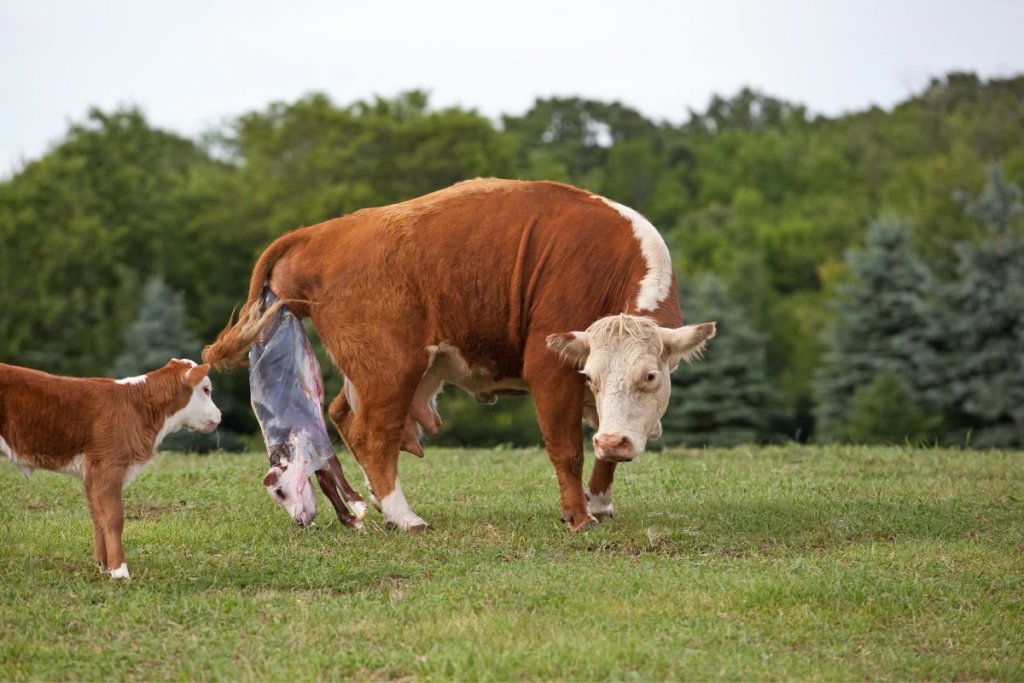The first 7 days after birth are critical for the health of the cow and calf. On the day of birth, calves are born within 2-5 hours after the appearance of a water bag. Good management of the calf during the first 24 hours influences the calf's overall lifetime health.
This article will discuss what happens during parturition (calving) and the first seven days.
Table of Contents
The Day Of Birth
On the day of birth, a cow will undergo three stages: dilation, delivery, and cleanup.
Stage 1: Preparatory Or Dilation Of The Cervix
During this stage, the cervix begins to dilate. Signs at this stage include restlessness, frequent standing and laying down, decreased appetite, isolation from the herd, raised tail head, and increased urination.
The calf will start positioning itself for delivery. Stage one lasts 2-6 hours.
Stage 2: Delivery
At the start of stage two, membranes (waterbag) will appear at the vulva. The heifer will lie on the ground because of heavy contractions. The delivery stage is where the fetal membranes and the calf enter the pelvic canal, which can result in a normal or abnormal presentation of the calf.
A normal presentation can be either anterior or posterior. Anterior means the front legs and head will emerge first, while posterior means the tail and hind legs will emerge first. With normal presentation, healthy heifers will calve within 1 hour without assistance.

An abnormal presentation can be in four ways.
- The forefeet appear without the head. The head might be backward or between the forelegs.
- The head is out, but one or both forefeet are retained.
- Breech presentation where the calf’s butt appears without the limbs.
- The tail emerges without the rear legs.
Abnormal presentation signals difficult calving and should be corrected first before pulling the calf.
When correcting abnormal presentations, make sure the cow is standing. When the cow is standing, you will correct malposition without hindrance from abdominal contents. It’s also essential to maintain cleanliness during this process.
Manual removal of the afterbirth is risky. Small parts may be left if you pull them, which can lead to infections. If the cow is not sick, the afterbirth can take up to 11 days to pass.
Stage 3: Cleanup
The uterus will continue to have uterine contractions to pass the placenta. The placenta (fetal membranes) should be passed within 8-12 hours after calving. If the placenta takes more than 24 hours to pass, it’s considered a retained placenta.
A retained placenta is associated with milk fever, twinning, vitamin E/vitamin A/selenium deficiency, dystocia, and low calcium. Since the cervix remains open, the retained placenta will naturally pass in 2-11 days. Manual removal of the retained placenta can cause uterine damage.
Retained placental membranes are common in cows that calves don’t nurse soon after birth. The act of suckling triggers uterine contraction and helps in releasing oxytocin. This is why vets recommend oxytocin injections for retained placentas.
Cows with prolonged and complicated retention of fetal membranes can develop mastitis, metritis, bovine viral diarrhea, endometritis, and ketosis.
Retained placentas are more common in dairy herds than in beef cattle.
A Calves First 24 Hours
Management of calves during the first 24 hours after birth influences their health and growth potential. A healthy calf should stand and nurse 2 hours after birth. For good colostrum intake, calves should nurse within 4 hours.
Calves that experience a difficult birth should be observed to ensure they can stand and nurse. If the calves don’t nurse within 4 hours, give them stored colostrum. The best colostrum is from the mother, but if not available, you can use beef cows, dairy cows, or dried colostrum.
A calf can absorb antibodies from colostrum efficiently in the first 12 hours. After 24 hours, calves cannot absorb the antibodies. The antibodies in colostrum help to start a calf’s immune system. Without a sound immune system, calves are more susceptible to diseases.
The umbilical cord (navel) should be disinfected immediately after calving to prevent infections which can be fatal.
What To Expect During The First 7 Days
For the first 3 days, calves are fed milk only, with water and calf starter introduced from the 4 day. A calf starter should contain adequate minerals, vitamins, and protein. Water and calf starter help with rumen development.
Calves sleep a lot, so they should be kept in a shed that is comfortable and can protect them from predators . The shelter should be well-ventilated during summer. The bedding should be thick, clean, and dry to prevent respiratory diseases.
Cows don’t eat much after calving, but they need proper nutrition for good body condition and milk production. Provide feeds with sufficient essential nutrients and easy access to fresh, clean water.
